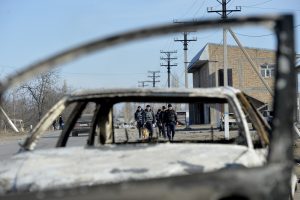Widespread clashes in several villages in Kazakhstan near the border with Kyrgyzstan left 10 people dead and 178 injured on the night of February 7. The following day, images of burned houses and torched car carcasses shocked the rest of the country, which had to grapple with another tragic incident caused by both ethnic and socioeconomic factors. A total of 47, believed to have taken part in the riot, were arrested.
For over a century, the villages of Masanchi and Sortobe have hosted a Dungan minority, that is, ethnic Chinese Muslims that fled China during and after the Hui Minorities War of the mid 19th century. Life in a few of these villages along the Kazakh-Kyrgyz border has not always been easy for Dungan people or other minorities in the intervening decades. A number of small-scale clashes have been recorded in Kazakhstan’s (and Kyrgyzstan’s) border zones in the past few years.
On February 10, Kazakh President Kassyn-Jomart Tokayev fired Askar Myrzakhmetov, governor of the Zhambyl region, replacing him with Berdybek Saparbayev, a veteran politician who served several times as minister and will be the leader of an oblast’ for the fifth time in his career. As vice prime minister, Saparbayev visited the villages after the riots and oversaw the creation of an investigative commission.
Earlier, Tokayev ordered the dismissal of several officials in charge of the districts in which the clashes took place, among which were the vice-governor and the top brass of the regional police.
The mob violence seemed to be directed mostly toward shops, homes, and cars owned by Dungans. Although the government chose to avoid mentioning the “ethnic” component of the clash, most witnesses did.
In the hours following the incident, fake news about “ruthless pogroms in Kazakhstan around the spreading of coronavirus” circulated around social media, fueling hysteria in other parts of the country.
More threats of violence pushed the administration to keep closed the Barakholka market on the edge of Almaty, 150 kilometers to the east, on the day following the incidents. Other villages with significant ethnic minorities, such as Zarya Vostoka near Almaty, were patrolled by extra police.
Inevitably, fear spread among Dungans who fell victim to the violence or witnessed the riot. Thousands crossed the border into Kyrgyzstan. Sortobe, on the Kazakh side and Tokmok, a village also populated by a few thousands Dungans, on the Kyrgyz side, are only separated by the Chu river, which also demarcates the border. According to Kazakhstan’s authorities, around 4,000 that had fled to Kyrgyzstan on February 8, returned two days later.
Interviewed by Vlast.kz, Khusei Daurov, chairman of the Dungan Association of Kazakhstan, said this is the first time that clashes between Kazakhs and Dungans have grown to such a scale.
“Someone beat me with a club [… ] and broke my arm. Another put a gun to my head,” Daurov told Vlast.kz.
According to Daurov’s account, several Kazakh families sheltered their Dungan neighbors from the violence on the streets. All accounts seem to point to petty violence turning into a widespread pogrom.
While the ethnic component turned out to be the foundation of the riot, the ethnic Kazakhs who targeted Dungans, did so to vent their disappointment for their socioeconomic conditions. Stoked up by envy towards some commercially successful Dungan businesses, some Kazakhs decided to seek revenge.
“The Dungans started to get cocky. […] Patience snapped. They got rich, and when people get rich, they start looking down on other people. They started saying to us: ‘Though the land is yours, the power is ours,’” a Kazakh man from a village near Masanchi told Eurasianet.
In a statement to the media, the Bureau for Human Rights, headquartered in Almaty, said the cause of the incident has its roots in “unresolved social problems, unemployment, social stratification, lack of social justice, and distrust of the authorities.”
By focusing on “interethnic harmony,” post-independence Kazakhstan has built a fragile house of cards that only holds when socioeconomic conditions are favorable for most. But as inequality, poverty, and injustice have become the scaffolding of Kazakhstan’s economy, especially after the 2007-2008 global financial crisis, violence has become the last resort for many disgruntled Kazakhs against those who have profited on their land, whether they have lived there for over a century, such as the Dungans, or for just a few months, such as expatriate workers in the oil fields.
































